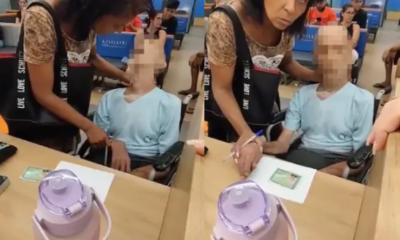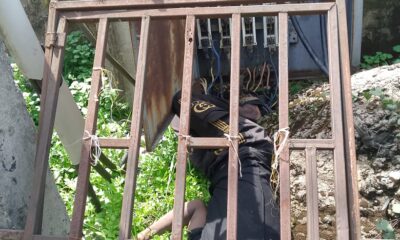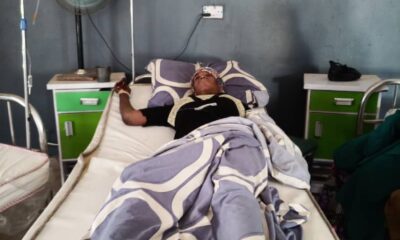Health
ILO, FG Release Survey On Evidence-based Data On Child Labour
Published
1 year agoon
By
Editor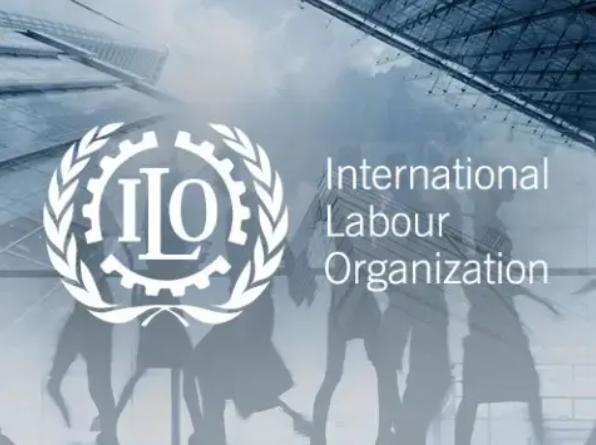
The International Labour Organisation (ILO) and Federal Government say they are set to release survey on evidence-based data on child labour and forced labour in the country.
Ms Vanessa Phala, the ILO Country Director for Nigeria and Ghana said this at the National Child Labour and Forced Labour Survey Validation workshop in Abuja on Monday.
The News Agency of Nigeria (NAN) reports that the workshop was organised by the ILO in collaboration with the Ministry of Labour and Employment, the ACCEL Africa Project, funded by the Netherlands Government and the National Bureau of Statistics.
According to Phala, after 22 years, Nigeria will eventually be able to comprehensively state its situation of child labour.
“For the very first time in Nigeria, we will be having data on the prevalence of forced labour, ‘’she said.
She said the last global report on child labour released by ILO and UNICEF, indicated that the number of children in child labour has risen to 160 million worldwide.
READ ALSO: Court Convicts Businesswoman Of N47.6m Agribusiness Scheme Fraud
The country director noted that there was an increase of 8.4 million children compared with the last report with millions more at risk due to the impacts of COVID-19 pandemic.
“In Nigeria, you will agree with me that eradicating child labour and forced labour requires the development of monitoring infrastructure to determine and measure its magnitude, distribution, dimensions and characteristics at the national and sub-national levels.
“For this reason, the ILO through its ACCEL Africa and Map 16 projects, supported the Government to conduct the National Child labour survey.
“The National Bureau of statistics with technical support from the ILO and participation of the Federal Ministry of Labour and Employment have gone to the field and it’s time to see the figures,’’ she said.
Phala noted that for over the past 20 years, the ILO continued its collaboration with Nigeria, through the Ministry of Labour and Employment and other ministries, agencies and departments to eliminate child labour and protect children within the legal working age.
According to her, so many children in Nigeria are trapped in slavery, forced labour and trafficking, they are forced to participate in community conflicts; used for prostitution, pornography or in illicit activities, exploited domestic workers, among others.
READ ALSO: Elections: INEC Issues Certificates Of Return To Winners In Lagos Thursday
“We must act urgently to protect the rights of our dear children and restore their childhood as the detail of this survey is of concern to all stakeholders.
“That is be it government, employers. workers, civil society organisation, academia, international organisations, donors. UN Agencies, parents, individuals, including the children themselves.
“We should start envisioning that change we intend to see in the next two years or seven years before the end date of the SDGs,’’ she said.
She charged all to contribute their quota to ensure that the evidence-based data on child labour and forced labour inform policy review, programming and implementation of various interventions.
Ms Daju, Kachollom, the Permanent Secretary, Ministry of Labour and Employment commended stakeholders for the conduct of the survey and their relentless efforts and commitment in the advocacy for the betterment of the Nigerian child, and the elimination of child labour.
“In Nigeria, child labour has become a scourge. Several children find themselves on the streets, forced to make a living with others employed in industrial complexes and hazardous environments.
READ ALSO: Airfares Soar As Foreign Airlines Hike Exchange Rate
“This is attributable to various factors such as poverty, ignorance, unemployment, absence of social security for the vulnerable, misinterpretation of cultural and religious beliefs and weak institutional framework.
“Statistics reveal that there are no fewer than 15 million child workers in Nigeria; this is according to the ILO, with the UN warning that the absence of mitigating strategies could see an exponential increase in the number of children engaged in child labour.
“As a country, however, we take pride in stating that giant strides have been made in dealing with this menace.
“Most notably the adoption and ratification of ILO Conventions 138 and 182 on Minimum Age and Worst forms of Child Labour respectively; the passage of the Child Rights Act into law to domesticate the Convention on the Rights of the Child, adopted by 35 state governments and the FCT,’’ she said.
She noted the review and the validation of the National Policy on Child Labour and the National Action Plan on the Elimination of Child Labour, Prohibition and Elimination of Forced Labour, Modern Slavery, and Human Trafficking in workplaces, amongst other achievements.
She, therefore, urged all to remain steadfast in the fight to eliminate child labour and to achieve the Alliance 8.7 of the Sustainable Development Goals (SDGs) and eliminating Child Labour in all its forms by the year 2025.
READ ALSO: Uncertainties Might Persist Amid High Risks To Financial Stability – IMF
Mrs Nike Ajala, the Abuja Office Liasion Officer, Nigerian Employers Consultative Association (NECA) said NECA would continue to played a critical role in the fight for the elimination of the worst forms of child labouring the country.
Ajala said that NECA had been engaging in tripartite discussions on the issue of child labour, providing inputs into legislation and encouraging the implementation of ILO child labour conventions’ principles at national, state and enterprise levels.
“Going forward, we will continue to seek deeper collaboration with other social partners in Nigeria.
“We will also continue advocating to our employers to improve their Corporate Social Responsibility.
“This is especially to ensure that children remain in school and encouraging companies to create policies to ensure that their suppliers operate responsible businesses without child labour among others.”
NAN/VANGUARD
You may like


FG Sets Up Committee To Oversee Cancer Health Fund


Presidency Unveils Platform For Citizens’ Feedback


BREAKING: FG Extends Public Holiday For Eid-El-Fitr Celebration


BREAKING: FG Declares Public Holiday For Eid-el-Fitr Celebration


FG Plans New National ID Card With Payment, Social Features


DMO Opens FG Savings Bond Subscription At 18.06%

By Silver Yeibake
Autism, commonly known as Autism Spectrum Disorder (ASD), is a neurodevelopmental disorder that affects communication, social interaction, and behavior. Autism is referred to as a spectrum condition since it can manifest in a variety of symptoms and abilities. While the actual cause of autism is unknown, evidence suggests that genetic and environmental factors interact to influence its development.
The risk factors include a sibling with autism, advanced age of parents, exposure to certain air pollutants and pesticides before birth, extreme prematurity, mothers with diabetes, immune system disorders or obesity, any difficulty with delivery leading to deprivation of oxygen to the baby’s brain, fever during pregnancy, lack of certain vitamins minerals during pregnancy, and certain genetic conditions, such as Down, fragile X, and Rett syndromes.
“Risk factors can not on their own cause a disease. However, they can increase the likelihood of that disease in a person.”
It is important to know that contrary to trending claims online, there is no scientific or medical evidence that vaccines or consumption of sugar are risk factors for autism.
READ ALSO: Kidney Stones: What You Need To Know
Autism is defined by difficulties in social interaction and communication. Individuals with autism may struggle to grasp social cues, maintain eye contact, and engage in typical back-and-forth conversations. Some people may also engage in meaningless, repetitive actions, such as hand-flapping or rocking, and have strong interests in specific areas.
It is essential to remember that autism is a lifelong diagnosis, but with early intervention and adequate care, people with autism can live fulfilling lives.
Autism treatment frequently includes behavioral therapy, speech therapy, occupational therapy, and social skills training. Each individual with autism is unique, thus interventions should be tailored to meet their personal needs and strengths.
In spite of the difficulties that autism can cause, many people with autism possess unique talents and abilities. Some people may succeed in fields such as music, art, mathematics, or programming, thus it is important for society to acknowledge and honor the qualities and achievements of people with autism.
In summary, autism is a complicated and diverse disorder that affects individuals in various ways. By raising autism knowledge, understanding, and acceptance, we can build a more inclusive society in which people with autism can thrive and attain their full potential.
Dr. Yeibake, Weriwoyingipre Silver.
Senior Registrar,
Faculty Of Pediatrics,
WACP
Health
Don Confirms ‘Zobo’ As Antihypertensive Therapy
Published
1 month agoon
March 10, 2024By
Editor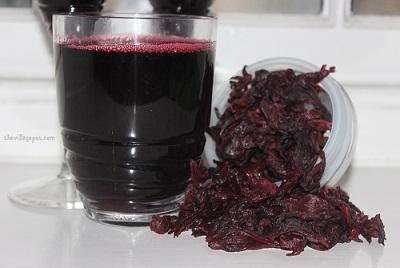
The Deputy Vice Chancellor, University of Nigeria Enugu Campus, UNEC, Prof. Daniel Nwachukwu, after research findings and clinical trials in both animals and human, has confirmed that Hibiscus Sabdariffa, popularly called ‘zobo’ drinks, has all the curative potentials as an antihypertensive therapy.
Nwachukwu, who is a Professor of Cardiovascular Physiology in the university, stated that the antihypertensive effectiveness of the Hibiscus Sabdariffa (zobo) was comparable to those of known antihypertensive drugs that are popular in the retail pharmacies, adding that zobo’s availability, cheapness and absence of side effects make it attractive as an alternative therapeutic agent in mind to moderate hypertensive subjects.
He however cautioned that care should be applied to avoid abuse in the consumption of Hibiscus Sabdariffa (zobo), adding that the therapy could interfere with some anti-malaria drugs while its high dose was also reported to have toxic effects on the liver and kidney.
READ ALSO: How Airline Pilots Fell Asleep Mid-flight – Safety Agency Reveals
Nwachukwu’s discoveries were contained his 201st Inaugural Lecture of the University of Nigeria with the topic “The Marriage Between the Cardiovascular System and Hibiscus Sabariffa: Let no One Put Asunder,” delivered at the moot court hall, Law faculty of the University of Nigeria, Enugu campus.
The DVC warned that Hibiscus Sabariffa consumption is not recommended for persons with low blood pressure because of its well established hypotensive action, advising that during combined therapy with antihypertensive drugs, the blood pressure, BP, must be carefully monitored.
He recommended that industrialists and investors should support large scale production of Hibiscus Sabariffa beverage and its distribution to rural communities in Nigeria, particularly since the raw materials (Hibiscus Sabariffa calyx and water) are cheap and readily available.
READ ALSO: Man Stabs Two Women To Death At A Mexico Varsity
According to Nwachukwu, “This lecture is intended to draw the public attention to our research efforts and unveiling the antihypertensive ability of Hibiscus Sabariffa which is called zobo in our common parlance. What we used for our studies was the same concentration as the locally produced zobo, and we found out that it exerted significant antihypertensive ability, in some cases even higher than the antihypertensive drugs and also did combination therapy with other antihypertensive drugs.
“What is significant is that this zobo is within us, it’s very cheap and it does not have any side effects compared to other antihypertensive agents. The raw material is just to buy zobo, prepare it under hygienic conditions, boil water and put it, sieve it and drink. It may have a sour taste but we do not encourage people to add things like pineapple or sugar in order to make it sweet, because once you do that, you are diluting or reducing its antihypertensive effectiveness.
“We have demonstrated it, both in animal studies and in humans. We are the first to do clinical trials, using mild to moderate antihypertensive Nigerians and we found it very useful. Some of the results show that one can actually use it and we equally saw that you can use it to prevent even diabetes from occurring because it reduces the rise in glucose level.”
READ ALSO: Adolescent Girls Face Risks Of Sexual Violence – UNICEF
Vice Chancellor of the University, Professor Charles Igwe while summarizing the lecture said that the lecture was in three dimensions; one on health grounds, another in academics and the third an economic value.
“Its economic in the sense that we can also begin to use what God has given us to make money. Maybe because God gave us everything in abundance in this country, we don’t recognize the simplest things God gave us in our environment. Therefore, what we are saying is that we should begin to, at all these pure water productions and incorporate zobo production so as to make money out of it.
“The university has made its contribution through our laboratories and it’s now left for the business community and the industries to come and buy into it and start widening it and make it very economic,” Igwe suggested.
Vanguard

By Silver Yeibake
Hi, did you know that Tuesday 12th March, 2024 is world Glaucoma day?Kindly avail yourself of this opportunity to learn about this important health issue as presented below:
Glaucoma is a dangerous eye disorder that damages the optic nerve, causing visual impairment or permanent blindness if not treated.
The optic nerve transmits visual information from the eye to the brain. Damage to this nerve might cause gradual visual loss that is not immediately obvious.
Worldwide, this disease affects 67 million people and contributes 6.7 million of blindness in this population. Glaucoma is the leading cause of blindness in the world.
The total number of cases is expected to increase to 111 million by 2040. Males are slightly more affected than females.
One of the basic causes of glaucoma is an increase in intraocular pressure (pressure within the eyeball), which can eventually damage the optic nerve (the nerve that makes seeing possible). This increase in pressure could be caused by an accumulation of aqueous humor, the fluid that nourishes the eye.
FROM THE AUTHOR: Food Poisoning: What You Need To Know
There are several forms of glaucoma, including open-angle glaucoma, angle-closure glaucoma, normal-tension glaucoma, and secondary glaucoma, each with unique characteristics and treatment choices.
Some of the risk factors for glaucoma include sustained elevation of intraocular pressure, family history of glaucoma, race (African, Asian), short-sightedness, long-sightedness, age over 50, previous eye injury or surgery, hypertension, diabetes mellitus, migraines, and prolonged steroid therapy.
Glaucoma symptoms may not appear until the problem has advanced sufficiently, therefore regular eye checks are essential for early detection. Blurred vision, eye pain, nausea, and light halos are some of the most frequent glaucoma symptoms. However, these symptoms might be mild or readily misinterpreted as other eye problems, emphasizing the significance of regular eye examinations.
Glaucoma treatment tries to reduce intraocular pressure and protect the optic nerve from further damage. This can be accomplished using a variety of approaches, including prescription eye drops, oral medicines, laser therapy, and surgical procedures. Treatment options are determined on the kind and severity of glaucoma, as well as personal characteristics such as overall health and medical history.
To summarize, glaucoma is a serious eye disorder that requires timely diagnosis and treatment to prevent irreversible vision loss. Regular eye examinations, early detection, and commitment to treatment plans are critical for protecting vision and eye health in glaucoma patients.
Thank you.
Dr. Yeibake, Weriwoyingipre Silver, a
Senior Registrar, Faculty Of Pediatrics, West Africa College of Physician (WACP), writes from Yenagoa, Bayelsa State.

Bandits Seek Peace Talks With Zamfara Gov In Viral Video

JUST IN: More Trouble For Bello As Immigration Service Places Ex-Kogi Gov On Watchlist

Police Rescue Three Toddlers Locked Up In Lagos Home

Woman S*xually Abuses Child, Films It In Viral Video

Jnr Pope: ‘That Guy No Suppose Knack Bell’ – Boat Captain Narrates His Own Side Of Story [VIDEO]

Junior Pope: ‘Our Boat Captain Hit Fisherman’s Canoe’ – Survived Actor Narrates How It Happened [VIDEO]
Trending

 Metro3 days ago
Metro3 days agoJunior Pope: Photos From Funeral Of Makeup Artiste, Abigail Frederick

 News4 days ago
News4 days agoVideo: Moment Pastor Enenche Sent Lady Away For Giving False Testimony On The Altar

 Metro2 days ago
Metro2 days agoTwo Soldiers Arrested For Allegedly Stealing Armoured Cables At Dangote Refinery In Lagos

 News3 days ago
News3 days agoBREAKING: APC Suspends National Chairman Ganduje

 Headline3 days ago
Headline3 days agoUS-based Nigerian Bodybuilder Dies 18 Days After Being Shot By Wife

 News2 days ago
News2 days agoBREAKING: FG Begins Disbursement Of N200bn Palliative Loans

 Headline1 day ago
Headline1 day agoB-I-Z-A-R-E: Woman Wheels Dead Uncle’s Corpse Into Bank To “Sign Off” Loan In Her Name [VIDEO]

 Metro2 days ago
Metro2 days agoTransformer Vandal Met Waterloo, Electrocuted In Benin

 News3 days ago
News3 days agoPastor Enenche Under Fire For Accusing Church Member Of Fake Testimony

 Metro4 days ago
Metro4 days ago‘Side Chick’, Family Members Allegedly Attack Lover’s Wife





















